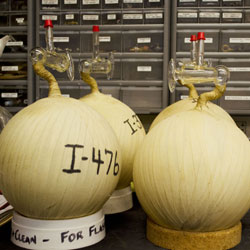Innovative and easy-to-use visualizations depicting aspects of climate change are available through the Keeling Curve website.
Record Annual Increase of Carbon Dioxide Observed for 2015
CO2 levels increasing at a faster rate than before
Measurement Note: An Adjustment to the Record
On Nov. 5, 2015, we made an adjustment to the Scripps Mauna Loa CO2 record that has the effect of increasing concentrations we have reported since April 2015
Video: Charles Keeling (1928-2005) and NOAA’s Mauna Loa Observatory
This short video produced by NOAA tells the story of how Charles David Keeling of Scripps Institution of Oceanography, UC San Diego, worked with scientists from the U.S. Weather Bureau and NOAA at NOAA’s Mauna Loa Observatory to create what is now an iconic record of carbon dioxide in our atmosphere. The measurements of carbon dioxide in the atmosphere taken … Read More
Is This the Last Year Below 400?
Leader of Keeling Curve measurement says temporary bump from El Niño could push atmospheric CO2 levels above symbolic threshold for good
Greenhouse Gas Measurement Summit at Scripps
Scripps Institution of Oceanography drew the world’s preeminent experts in the measurement of greenhouse gases
American Chemical Society to Honor Keeling Curve in June 12 Ceremony
Scripps Oceanography lab monitoring atmospheric CO2 named National Historic Chemical Landmark
What Does This Number Mean?
Repost of April 2013 entry The Mauna Loa carbon dioxide (CO2) record, also known as the “Keeling Curve,” is the world’s longest unbroken record of atmospheric carbon dioxide concentrations.
Researcher Confronting Climate Change with Coral Reef Mosaics
Tim Lueker combines research and art to portray environmental change
A Keeling Curve Funding Update – April 2015
The Scripps Institution of Oceanography, UC San Diego O2 and CO2 programs have received funding from multiple sources that put these operations on a relatively secure footing for the next few years.


